If you visit Barcelona for the first time and dream of seeing “everything that should be seen”, then you can give up this idea. We present a plan for a weekend trip that allows you to view a few of the most important places on the map of this city. Nothing prevents you from spreading this trip for more days. We assume, however, that you are ready for an intense weekend in Barcelona!
Aeroport de Barcelona-El Prat (Google Map)
An intense weekend in Barcelona is rather a trip for persistent travelers. Good condition required, but in return we offer unique experiences packed in 2.5 days. The trip contains practically all the most important points that are worth visiting in the city, unfortunately there is not too much time to go into the atmosphere of the city. If you want to feel Barcelona – choose a longer trip.
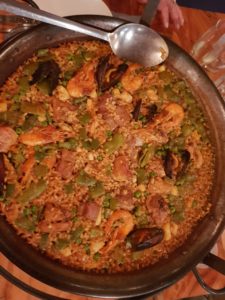
Day 1: Friday (arrive in Barcelona)
After checking in a hotel (we stayed in Salles Pere IV) we are going to the city! Locate the nearest tapas bar and eat and drink there. Often there are some combined menus (like 4 tapas, a drink and a dessert for 10-12 euro). If you came earlier – do not forget to include one of the beautiful beaches. For the hungry – eat near the Marina (not sure what to eat? Choose Paella or other delicious Catalonian dishes). We were in Marina Bay by Moncho’s – 20 euros is degustation menu (4 different starters, including mussels, bread and tomato, salad and little fishes, then one main dish: fish, meat or paella and than Crema Catalana for dessert).
Walking: light.
Day 2: Saturday
(metro: Jaume I)
We start the day with the Gothic quarter. Get off at Jaume I and head for Carrer de Jaume I. On the left is the Roman city walls from the 4th century.
Barcelona was founded by the Phoenicians. As a Roman colony it was founded in the 3rd century BC and thus it developed as one of the most important ports in the Mediterranean. After the Romans (Carthaginians, then Romans and Visigoths) in the eighteenth century, conquered for 100 years by the Moors, then Charles the Great. It was then part of an independent county, the capital of the Kingdom of Aragón. From the eighteenth century, Barcelona was an arena of many battles (for Spanish succession, in Napoleonic wars, in civil war). At the same time, in the 20th century, it experienced a commercial and industrial flourishing.
From 1939, Barcelona became the centre of the resistance and national consciousness of the Catalans.
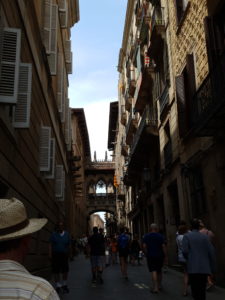
After looking at the city walls, head towards Barri Gotic. The centre of the Old Town stretches from the Mediterranean coast to the Sant Pere roundabout and between La Rambla and Via Laietana. Rebuilt and rebuilt in the 19th and 20th centuries, it also contains the former Jewish quarter El Call. The complicated and twisted street layout is practically off of vehicular traffic.
After a walk between medieval tenements, head to Basilica dels Sants Martirs Just and Pastor – one of the oldest churches in the city. For fans of views for 2 euros, you can go to the belfry. Warning! The church is open between 11 a14 and 17 a.m. and 21 a.m. from Monday to Saturday and on a Sunday from 10 to 13.
Move away from Via Laietana and head to Place de Sant Jaume, where you will find the town hall and the Catalan government buildings. You have a great chance to hit an event (festival, crib, etc.).
Look out for the famous arch (Pont Gotic) between the buildings at Carrer del Bisbe. You can go this street to  the Cathedral of Barcelona. For 7 euros, we have the opportunity to visit the interior of the church together with the famous tomb of Saint Eulalia, as well as the gardens (with 13 goose symbolizing the patron’s age and a fountain). In the following, we can visit various paintings, including Pieta by Bermejo.
the Cathedral of Barcelona. For 7 euros, we have the opportunity to visit the interior of the church together with the famous tomb of Saint Eulalia, as well as the gardens (with 13 goose symbolizing the patron’s age and a fountain). In the following, we can visit various paintings, including Pieta by Bermejo.
Built on a Roman temple between the 13th and 15th centuries, it is one of the most valuable examples of Gothic in the country, it received a neo-gothic façade in the 19th century.
(around year 300), persecuted and humiliated in Barcelona. Legend has it that they have been stripped naked in public, but snow has fallen and spared her humiliation. Buried in the Cathedral. She was just 13. Now in the Cathedral, there is always 13 goose living in the gardens.
This is not the end of the churches on our route. Another one that we can visit is the church of Santa Maria del Pi (Our Lady of the Pine). Apparently, the first Christian temple was built here around the fifth century, but it is certain that in the tenth century there was already a capillary – of course far outside the walls of Barcelona. The church itself is from the fourteenth century and has survived to this day almost without renovation.
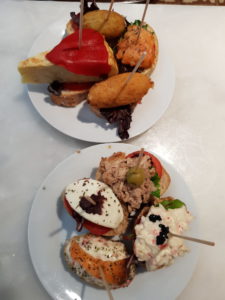
If you have not taken a lunch break (BUT WHY?!) then the interesting place can be El Drac de Sant Jordi – for 10 euros we can choose 4 sandwiches, drink and a mini portion of dessert.
 Once you are satisfied with the atmosphere of the Middle Ages, it is time to leave the Gothic and take a walk around some of the newer parts of the city.
Once you are satisfied with the atmosphere of the Middle Ages, it is time to leave the Gothic and take a walk around some of the newer parts of the city.
We head west, towards the famous La Rambla. It is still in Barri Gotic, but you can see completely different buildings. At the end we will find, by the sea, a monument to Christopher Columbus, on the other hand – the Catalan Square. Interestingly, Rambla itself is really a collection of streets called Rambla (hence Las Ramblas – in plural). At Rambla, we can find everything – street artists, tourists, locals, cafes, shops, stalls, but also thieves. On the street, you will find two places of interest.
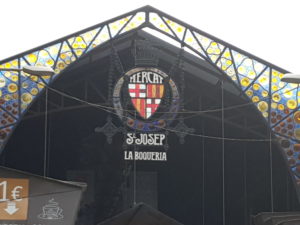 A little more north is worth seeing La Boqueria. This city market is over 800 years old! Today, as in the past, we find here Catalan specialities: spices, meat, bread, fish, seafood, sweets, vegetables and fruits, as well as several bars where you can try different of these specialities. It is worth taking a close look at the fish stands to get to know the potential dinner menu.
A little more north is worth seeing La Boqueria. This city market is over 800 years old! Today, as in the past, we find here Catalan specialities: spices, meat, bread, fish, seafood, sweets, vegetables and fruits, as well as several bars where you can try different of these specialities. It is worth taking a close look at the fish stands to get to know the potential dinner menu.
The full name of the market is Mercat de Sant Josep de la Boqueria – because the market hall was built on the site of St. Joseph’s church. The very name Boqueria comes from the “place where goat meat is sold”. Seriously.
A bit south of the church you will find the Gran Teatre del Liceu – opera. One of the best in the world opened in the mid-nineteenth century. The name, as you have probably noticed, reaches the word liceum (high school), because it was created on the basis of the Dramatic-Philharmonic Liceu created from private money in a sacred monastery. Later transferred to Las Ramblas, built own building. Because Queen Izabela II did not add a coin to the project – there was no royal box in the theatre. There were a lot of sold seats- sponsors could not only buy seats in the opera itself but also in the building – to be able to open a shop or club. In 1861, the fire burned most of the opera, so it was rebuilt almost from scratch (living only the façade and several fragments). A similar Liceu fire survived in … 1994! This time, the facade, foyer and part of the entrance hall were also preserved. The reconstruction lasted 5 years.
After Liceu, we can go south a little to Reial Square. It is not only a living place with lots of restaurants and often live music, but also an interesting example of Barcelona’s urban architecture. On the square, there are also lamps designed by Gaudi (one of his first works).
After leaving the square we head west to the Palace Guell. The entrepreneur not only commissioned the construction of the whole estate (currently Park Guell) but asked Gaudi to design his home. Much more party than Casa Mila or Batillo. Open to visitors.
If it’s time for dinner, and if not, it’s okay, because going between the streets get to Canete – a nice tapas restaurant. The portions are small but delicious. Remember about the booking. We succeeded that after the arrival we waited only an hour to plant. Yes, this place is so good (and popular).
At Las Ramblas you will also find very interesting old shops and cafes that are worth visiting at least.
 You can walk further north on Rambla, but you probably have legs hurting, so you can take the metro in Liceu and drive up to Plaza Catalunya.
You can walk further north on Rambla, but you probably have legs hurting, so you can take the metro in Liceu and drive up to Plaza Catalunya.
At the end of Las Ramblas you will find the Font de Canaletes – if you are a football fan you can wait for someone to celebrate the victory. Otherwise, you can just drink water.
Head north to the square. It has 50,000 square meters, you’ll find hotels, shops and various companies around. It is also an important hub for public transport. Different districts meet here and meet important streets. The square itself does not make a phenomenal impression, although it has nice sculptures and a fountain. We will also find here the monument of Catalunya and Francesc Macià. The Catalan Square is quite fresh – it was built in the plans of a general reconstruction of the city in the 19th century when the city walls were demolished, and later fragments of the city were added to world exhibitions (including 1888 and 1929).
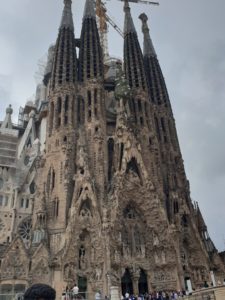 The last point of the program is the main city monument – Sagrada Familia. To get there, get on the Pl. Catalunya metro and get off at the Sagrada Familia station.
The last point of the program is the main city monument – Sagrada Familia. To get there, get on the Pl. Catalunya metro and get off at the Sagrada Familia station.
The Penitential Temple of the Holy Family is the work of Antoni Gaudi. It is a temple in eternal construction, which began in 1882. Initially, the project was to be carried out by another architect, but due to the conflict, it was handed over to Gaudi. The artist devoted 15 years of his life by transforming the building until 1926, when he died under the wheels of the tram. He was buried in the interior. Six years earlier, the towers were completed, and in the year of the architect’s death was only one of the three facades. During the Spanish Civil War, the building designs were destroyed and the building itself damaged.
Why is construction taking so long? Mainly because each element is unique and made by hand (and also due to some construction restrictions). In 2010, the Sagrada Familia became a smaller basilica. The planned end of work is 2028.
The building is on the UNESCO list of heritage in Europe.
A nice place to eat dinner can be a cosy place near Sagrada – A Angelo Marcelo. You will find traditional Catalan cuisine based more on meat.
Day 3: Sunday
 The second day will be even harder than the first. We start with an active sport – go up to Vallcaraca subway and head to Park Guell. Yes, you will climb up sharply, luckily – there are escalators in many sections. When will you get to Av. del Coll del Portel you can choose a further climb to the main entrance of the park or lower down and go straight to Gaudi’s buildings. I encourage you to choose the upper entrance – it still requires some effort, but it provides beautiful views of the city. Going down below, we can see the architect’s works from above. Entrance to the park is free – outside the space with the buildings of the creator of Sagrada. This is where you will find the famous lizard from mashed pottery or towers in the shape of muffins with cream. You will also find Gaudi’s museum there.
The second day will be even harder than the first. We start with an active sport – go up to Vallcaraca subway and head to Park Guell. Yes, you will climb up sharply, luckily – there are escalators in many sections. When will you get to Av. del Coll del Portel you can choose a further climb to the main entrance of the park or lower down and go straight to Gaudi’s buildings. I encourage you to choose the upper entrance – it still requires some effort, but it provides beautiful views of the city. Going down below, we can see the architect’s works from above. Entrance to the park is free – outside the space with the buildings of the creator of Sagrada. This is where you will find the famous lizard from mashed pottery or towers in the shape of muffins with cream. You will also find Gaudi’s museum there.
(25 June 1852 – 10 June 1926)
Catalan architect, representative of modernism. He inspired himself in his works with nature, religion and neo-Gothic and orient. His works are unique, also because instead of drawing them, Gaudi built three-dimensional models. The spiritualized works gave him the nickname of the Architect of God and cause that many people think that he should be beatified. Some see commitment to religion in Gaudi’s life because of his very poor health and many diseases in childhood.
One of the first projects after the school born in Catalonia, the architect were lamps at the Reial Square. In 1878 at the Paris World’s Fair, Gaudi seduces entrepreneur Eusebi Guell, thanks to which he receives a number of orders, including a park, palace, wine cellars, crypt or pavilion (all named Guell). In 1883, work began on the Basilica and Expiatory Church of the Holy Family, but only from 1915 (until his death) is devoted exclusively to the Sagrada Familia. After the World Fair in 1888, Gaudi becomes a famous architect not only in Catalonia and the surrounding area, but also all over Spain, receiving projects from other towns. All the time he worked on the projects in Bracelon – at the beginning of the century he was involved in the unsuccessful urban project Park Guell (it was to be a housing estate for the bourgeoisie, now outside a few buildings and an amphitheater it is a park, in the park Gaudi lived in 1906-1925 – now there is an architect’s museum here), in the years ’04 -10 he created famous works such as Casa Batllo or Casa Mila.
The next decade was difficult for Gaudi – many of his friends died (including Guell) and members of his family, there was an economic collapse in the country (hindering the construction of the “Chair for the Poor”), and the architect himself underwent further fatal diseases. He remained lonely all his life. Therefore, from 1915 he devoted himself solely to the construction of the cathedral.
“I have no friends, I can not dedicate myself to the Church”
Unfortunately, in 1936 during the Spanish Civil War the genius workshop was attacked, and many materials and plans – destroyed.
While at the beginning of his life handsome “Dante of architecture” dressed tastefully and fashionable, at the end of his life he did not care about the mundane coating. Therefore, when on June 7, 1926 during a walk to the church on Gran Via de les Corts Catalanes, tram number 30 hit him, no one bothered with an unconscious beggar without documents. Before he received the help he needed, his health deteriorated. He died three days later, at the age of 73.
It is worth remembering that it was Gaudi who proposed trencadis – the technique of using wasted ceramic pieces, and although we are talking about him as a modernist – his works elude an unambiguous nomenclature. In the course of his life, he created amazing works, yielding to various influences, and many of his works are on the UNESCO list.
After visiting the park, you can return to the station Vallcaraca or choose Lesseps down and a little further. From there, we move to the next architect’s works – get off at the Diagonal station and head down to Passeig de Gracia. You will not only see the stores of the most expensive designers and brands, but you can also visit two tenement houses from the first decade of 1900 – Casa Mila and Casa Batllo (both on UNESCO list).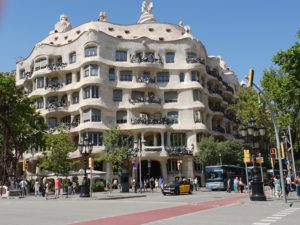 Casa Mila, nicknamed the Quarry (due to construction), is a private building open to visitors. There is an underground garage, modernist apartments and a large roof terrace. We will not find any angles or bearing walls, as well as a statue of the Mother of God, which was supposed to be there, but eventually it was abandoned (just like other religious symbols). If you decide to go up, pay attention to the chimneys called espanta bruixes (witch scarers). They are so twisted and unusual that we are scared of them. This is not the only thing to pay attention to on the roof. One of the chimneys is encased in glass from 20th century Champagne bottles. Legend has it that Gaudi has stuck this glass, which was left after the opening event of the Casa Mila. The whole building aroused much controversy (from construction, through sacred figurines to finishing) and was the source of jokes and satirical drawings. For many years, the inhabitants of Barcelona criticized the work, already well-known architect, and other homeowners were criticizing Pere Mila for reducing the value of the area. After the architect’s death, the wife of the house owner – Rosa Segimon – covered some of Gaudi’s works and sold many pieces of furniture from the house.
Casa Mila, nicknamed the Quarry (due to construction), is a private building open to visitors. There is an underground garage, modernist apartments and a large roof terrace. We will not find any angles or bearing walls, as well as a statue of the Mother of God, which was supposed to be there, but eventually it was abandoned (just like other religious symbols). If you decide to go up, pay attention to the chimneys called espanta bruixes (witch scarers). They are so twisted and unusual that we are scared of them. This is not the only thing to pay attention to on the roof. One of the chimneys is encased in glass from 20th century Champagne bottles. Legend has it that Gaudi has stuck this glass, which was left after the opening event of the Casa Mila. The whole building aroused much controversy (from construction, through sacred figurines to finishing) and was the source of jokes and satirical drawings. For many years, the inhabitants of Barcelona criticized the work, already well-known architect, and other homeowners were criticizing Pere Mila for reducing the value of the area. After the architect’s death, the wife of the house owner – Rosa Segimon – covered some of Gaudi’s works and sold many pieces of furniture from the house.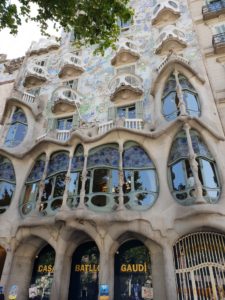 Casa Batllo, Casa dels ossos (House of Bones) – due to visceral and skeletal organic quality. We find here a lot of trencadis (decorations with a mosaic tiles of broken ceramic tiles) and references to Saint George defeating the dragon. A common theory of the Saint of Saint George (patron saint of Catalonia, Gaudí’s home), which has been plunged into the back of the dragon (the roof is arched and was likened to the back of a dragon). The Batllo family was known in Barcelona as a textile entrepreneur.
Casa Batllo, Casa dels ossos (House of Bones) – due to visceral and skeletal organic quality. We find here a lot of trencadis (decorations with a mosaic tiles of broken ceramic tiles) and references to Saint George defeating the dragon. A common theory of the Saint of Saint George (patron saint of Catalonia, Gaudí’s home), which has been plunged into the back of the dragon (the roof is arched and was likened to the back of a dragon). The Batllo family was known in Barcelona as a textile entrepreneur.
We take the metro Passeig de Gracia and head for the Paral lel. There, we change to the station for a special train (funicular) towards Montjuic (still on the city ticket). The rail queue will lead us to Teleferic, a gondola lift – hanging over Montjuic. Tickets in 2 pages are less than 13 euros, but it is worth investing, because the views are beautiful.
The entrance to the mountain is about 10 minutes drive, and at the top you will find, in addition to the picnic space, the castle.
Castell de Montjuïc, dated 1640, was built as a fortress. It was only 50 years later that it was rebuilt into a castle, and another 50 years later – it was clearly modernized. Over its 350 years, the fort has been an important point in wars, a prison and an important historical pound for the city or a symbol for the Catalans. Next to the castle we have a beautiful view of the harbor.
Returning after seeing the summit, stop at the postage station (available only on return) to see the Mirador de l’Alcalde – the observation deck with beautiful fountains and … a view of Barcelona.
If you have time to detour – come back from Paral lel to Arc de Triomf. Pass the majestic triumphal arch and go to the park where the citadel (Parc de la Ciutadella) was located. There you will find the Monument Cascada – a beautiful monument with fountains and stairs. For ambitious – on the other side you will find the ZOO.
 If, however, the 9 o clock is approaching, definitely go to the Spanish Square (Pl. Espanya). In the direction of the MNAC (Museu Nacional d’Art de Catalunya) you will find the Magic Fountain (Font màgica). Performances last every 30 minutes during the summer at 9 and 9.30 in the evening. The view is spectacular.
If, however, the 9 o clock is approaching, definitely go to the Spanish Square (Pl. Espanya). In the direction of the MNAC (Museu Nacional d’Art de Catalunya) you will find the Magic Fountain (Font màgica). Performances last every 30 minutes during the summer at 9 and 9.30 in the evening. The view is spectacular.
Unfortunately, it’s hard to get a good place for dinner nearby. I recommend going back to the Urquinaona metro and go to La Cuina de Laietana. They have a delicious Sangria there as well as starters, seafood and of course Paella.
Do not worry if you do not fit everything. You can give up various elements in favour of others. The main thing – feel the magic energy of Barcelona.